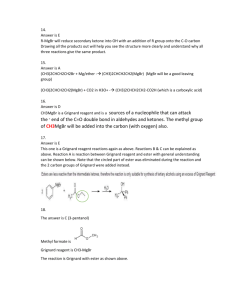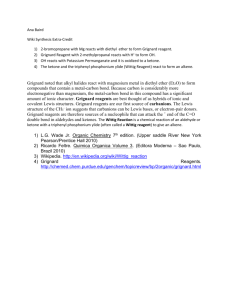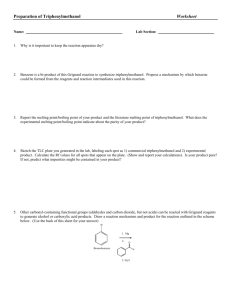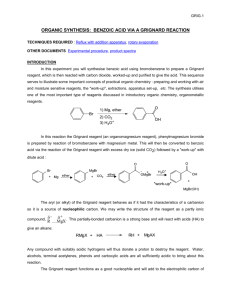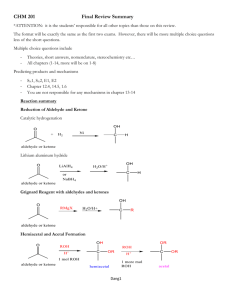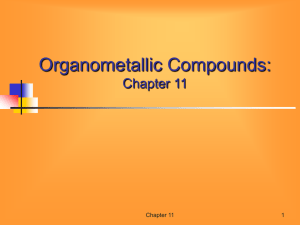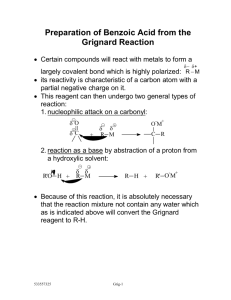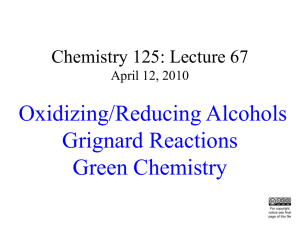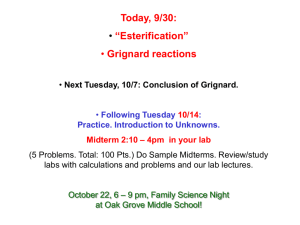Organometallic Chemistry
advertisement
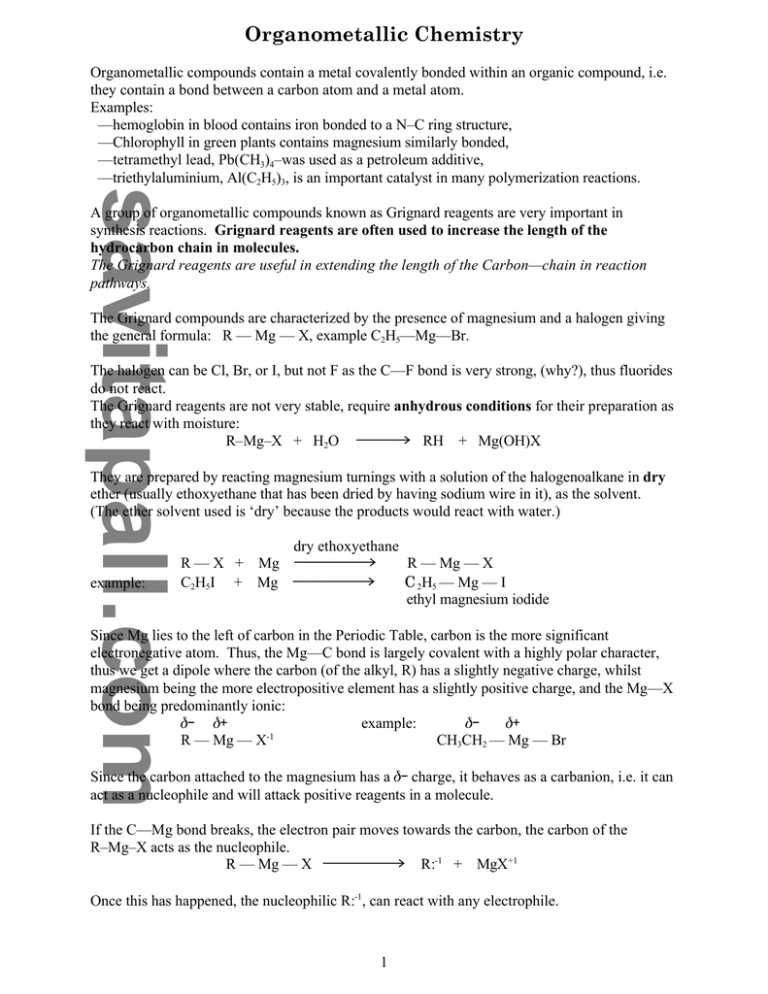
Organometallic Chemistry Organometallic compounds contain a metal covalently bonded within an organic compound, i.e. they contain a bond between a carbon atom and a metal atom. Examples: —hemoglobin in blood contains iron bonded to a N–C ring structure, —Chlorophyll in green plants contains magnesium similarly bonded, —tetramethyl lead, Pb(CH3)4–was used as a petroleum additive, —triethylaluminium, Al(C2H5)3, is an important catalyst in many polymerization reactions. A group of organometallic compounds known as Grignard reagents are very important in synthesis reactions. Grignard reagents are often used to increase the length of the hydrocarbon chain in molecules. The Grignard reagents are useful in extending the length of the Carbon—chain in reaction pathways. The Grignard compounds are characterized by the presence of magnesium and a halogen giving the general formula: R — Mg — X, example C2H5—Mg—Br. The halogen can be Cl, Br, or I, but not F as the C—F bond is very strong, (why?), thus fluorides do not react. The Grignard reagents are not very stable, require anhydrous conditions for their preparation as they react with moisture: R–Mg–X + H2O sssd RH + Mg(OH)X They are prepared by reacting magnesium turnings with a solution of the halogenoalkane in dry ether (usually ethoxyethane that has been dried by having sodium wire in it), as the solvent. (The ether solvent used is ‘dry’ because the products would react with water.) example: dry ethoxyethane R — X + Mg sssssd R — Mg — X C2H5I + Mg sssssd C2H5 — Mg — I ethyl magnesium iodide Since Mg lies to the left of carbon in the Periodic Table, carbon is the more significant electronegative atom. Thus, the Mg—C bond is largely covalent with a highly polar character, thus we get a dipole where the carbon (of the alkyl, R) has a slightly negative charge, whilst magnesium being the more electropositive element has a slightly positive charge, and the Mg—X bond being predominantly ionic: % $ example: % $ R — Mg — X-1 CH3CH2 — Mg — Br Since the carbon attached to the magnesium has a % charge, it behaves as a carbanion, i.e. it can act as a nucleophile and will attack positive reagents in a molecule. If the C—Mg bond breaks, the electron pair moves towards the carbon, the carbon of the R–Mg–X acts as the nucleophile. R — Mg — X sssssd R:-1 + MgX+1 Once this has happened, the nucleophilic R:-1, can react with any electrophile. 1 I. Reaction of a Grignard reagent with a carbonyl compound, (i.e. an aldehyde or ketone). R:-1 R` \ $ % H+1 + C = O sssssd ``R / MgX+1 + OH-1 R` | R—C—OH | ``R sssssd Mg (OH)X Typical reactions of Grignard reagent which increase the length of the carbon chain occur in two steps: 1. Addition of the Grignard reagent. 2. Hydrolysis in acid solution. In general, the electrophilic carbon of a carbonyl (i.e an aldehyde or ketone) reacts with the nucleophilic carbon of the Grignard reagent to form an alkoxide . R— MgX sssssd R-1 + Mg X+1 R | | -1 R + R’— C = O sssssd R’—C—O-1 $ % | Hydrolysis of the alkoxide ion then gives the alcohol. | R’—C—O-1 + H–OH ssssd R’—C—OH + OH-1 | ( | R R Mg X+1 + OH-1 sssssd Mg(OH)X Aldehydes react with Grignard reagent to give secondary alcohols, whilst ketones react with Grignard reagent to give tertiary alcohols. Methanal, is the only aldehyde that reacts with Grignard reagent to give a primary alcohol. Example: The reaction of methylmagnesium bromide and propanone The first step is where the nucleophilic carbon of the Grignard reagent behaves as a nucleophile and attacks the electrophilic carbon of the propanone. The p-bond of the carbonyl, (C=O), is broken and those two electrons are transferred to the more electronegative oxygen, making the anion. In the second step, hydrolysis is required in which aqueous acid is added to protonate the alkoxide ion and generate the alcohol product. O || '( + H3C CH3 % $ CH3 — Mg — Br sssd O-1 H2O OH | sssd | + Mg (OH)Br '|( '|( H3C CH3 CH3 H3C CH3 CH3 2 The reaction of methylmagnesium bromide and methanal Br— Mg — C2H5 + H | C=O | H H H–OH | sssssd C2H5— C—OH | H + Mg(OH)Br Mechanism: $ % Br— Mg — C2H5 C2H5-1 + H | C=O | H MgBr+1 + OH-1 sssssd C2H5-1 + MgBr+1 H | C2H5— C—O-1 | H ssssd H — OH C2H5— CH2—OH + OH-1 ssssd Mg(OH)Br II. Reactions of Grignard reagent with water: An alkane is formed CH3CH2 — Mg — Br + H2O sssssd CH3CH3 + Mg(OH)Br III. Reactions of Grignard reagent with carbon dioxide: a carboxylic acid is produced C3H7 — Mg — Br + CO2 sssssd C3H7COOMgBr propyl magnesium bromide The salt of the carboxylic acid is first formed and then the carboxylic acid is generated by adding a dilute strong acid such as sulphuric acid: H+1 C3H7COOMgBr + H2O sssssd C3H7COOH + Mg(OH)Br butanoic acid The conditions for the first step must be completely free of water—thus dry CO2 is passed through the Grignard reagent dissolved in dry ether as solvent. Note: that the length of the carbon chain has increased by one carbon atom. 3 Again the reactions of the Grignard reagent may be explained as the initial attack of the nucleophilic carbon from the C–Mg bond to form a bond to $C—atom. $ % Br— Mg — C3H7 % $ % H2O /H+1 + O = C = O sssd C3H7 — C = O ssssd | O-1 + MgBr+1 Summary: Reactions of Grignard reagents 1. + H2O sssssd alkane 2. + methanal sssssd primary alcohol sssssd secondary alcohol + aldehyde 3. + ketone sssssd tertiary alcohol 4. 5. + CO2 sssssd carboxylic acid Reaction with Lithium Just as magnesium reacts with alkyl halides to form Grignard reagents, lithium metal reacts with alkyl halides to form organolithium reagents. This is another example of organometallic compounds. % $ R—X + Li sssssd R — Li —X Organolithium reagents are characterized by a C–Li bond, which is polarized similarly to the % $ C–Mg bond of a Grignard reagent, C–Li bond has the polarization C—Li . The C—Li bond is more highly polarized than the C–Mg bond. Therefore the % charge on the carbon of the organolithium reagent is greater (more carbanionic). Organolithium reagents will, therefore function os nucleophiles in the presence of an electrophilic species such as ketones and aldehydes. Assignment 1. When bromoethane reacts with magnesium in the presence of a nonpolar solvent, a Grignard reagent is formed. a. Give the equation for the reaction of this Grignard reagent with water. b. This Grignard reagent can also react with an aldehyde or a ketone to form an alcohol. State the names and the formulas of the alcohols formed when the Grignard reagent reacts with: i. Ethanol ii. Propanone. [Answer: a. C2H5MgBr + H2O —> C2H6 + Mg(OH)Br b. i. Butan-2-ol: C2H5CH(OH)CH3 ii. 2-methylbutan-2-ol: C2H5 C(CH3)2(OH) ] 2. State the formulas of the products, A and B formed in the following reaction: (CH3)2CO + CH3CH2MgBr —> A + B [Answer: A = (CH3)2C CH3CH2(OH), B = Mg(OH)Br ] 4 3. Starting with chloromethane, outline a reaction pathway to synthesize ethanoic acid. [Answer: Step I: Step II: CH3Cl + Mg —> CH3MgCl ( in dry nonpolar solvent: ether) CH3MgCl + CO2 —> CH3COOH + Mg(OH)Cl ] H2O 4. Draw the structure of the final organic products formed when CH3CH2CH2MgBr reacts with the following compounds: a. CO2 b. Propanone c. CH3CH2CHO [Answer: a. Butanoic acid, b. 2-methylpantan-2-ol, c. Hexan-3-ol ] 5. a. Name two aldehydes that could be reacted with suitable Grignard reagents to produce pentan-2-ol. b. Give the structural formula of a Grignard reagent that can be reacted with propanone to form 2-methylhexan-2-ol. [Answer: a. ethanal or butanal, b. CH3CH2CH2CH2MgX ] 6. a. b. c. Give reaction sequences for the following transformations: Ethanal to butan-2-ol 2-chloropropane to propane 2-chloropropane to 2-methylpropanoic acid. [Answer: C2H5MgI a. CH3CHO sssssd CH3CH(OH)C2H5 dry ether dry ether H2O b. 2-chloropropane + Mg sssssd CH3CH(CH3)MgCl sssssd CH3CH2CH3 dry ether (i) CO2 c. 2-chloropropane + Mg ssssd CH3CH(CH3)MgCl ssssd CH3CH(CH3)COOH (ii) H+1/H2O 7. State the formulas of the organic substances A, B, and C formed in the following reaction pathways: + HBr + Mg + C3H7CHO ssssd B sssssd C CH2 = CH—CH3 sssd A (major product) + H2O / H+1 [Answer: A = CH3–CH(Br)–CH3 B = (CH3)2CHMgBr 5 C = C3H7CH(OH)CH(CH3)2 ]

